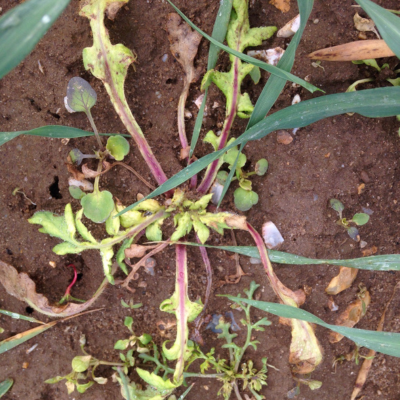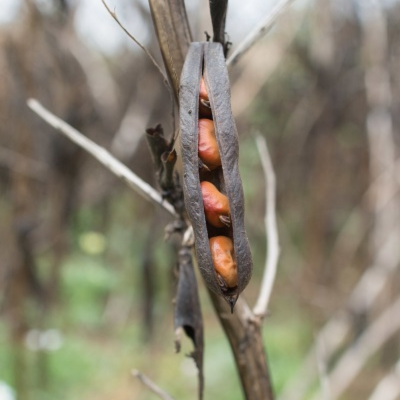The majority of broad-leaved weeds (BLW’s) are not an issue in the autumn or early spring, many being well controlled through residual chemistry. However, the warm autumn, high seed return from last season and the use of narrower spectrum residual chemistry will result in poor control of many difficult, yield robbing weeds.
Historically, wider spectrum residual chemistry and frosty conditions would contain gemination and growth in the autumn period, putting a hold on broad-leaved weeds until spring. Changing cultivation practices, such as no till systems, are also encouraging germination of populations with shallow buried weed seeds and those with tap roots.
As warmer autumns become the norm, this has significantly enabled autumn germination and consequently increased weed biomass by the spring making control of these large, overwintered weeds difficult.
The most problematic BLW’s in cereals have a significant autumn germination period and include mayweed, groundsel, poppy, cleavers, cranesbill, chickweed, fumitory, umbelliferous species, volunteer beans and oilseed rape.
“Getting ahead of broad-leaved weeds in cereals early is essential to limit the impact of competition for resources and ultimately yield. There are also benefits to overall costs, as it is often cheaper to target smaller weeds with lower rates early in the season, when compared to later applications on larger weeds that may require a higher use rate and may also result in compromised levels of control. Removing weeds from the crop early also simplifies later season tank-mixes and product selection”.
Hugh Guinan, Corteva Cereal Herbicides, Field Technical Manager

Corteva products such as Spitfire® or Zypar® offer cost effective control against a large spectrum of challenging broad-leaved weeds such as cleavers, poppy, cranesbill, fumitory, chickweed, volunteer beans and groundsel.
They have approvals for use in winter wheat, barley, oats, rye and triticale.
They are the best suited class of chemistry for post emergence, late autumn or early spring weed control as they have dose rate flexibility, are unaffected by cold or fluctuating temperatures, but still achieve a fast knockdown in difficult conditions.
Another key aspect for this timing is that these products can be tank mixed with a wide range of combinations to coincide with workload and passes, such as a top up residual spray, a BYDV spray or an early spring application (check tank mix list for specific product details).
Zypar, Spitfire and Nevada® are all rain fast in 1 hour and for all crops can be applied form GS13.
The maximum autumn dose for Zypar is 0.75L/ha up to 14th February. 1.0L/ha can be applied from 15th February for all label crops except winter oats where the maximum dose is 0.5L/ha.
The maximum autumn dose for Spitfire or Nevada is 0.75L/ha up to 1st February. 1.0L/ha can be applied after 1st February.
If applications are made in the autumn, all have a range of ALS sequences and the dose rates allow for follow up applications of both florasulam and Arylex™ later in the spring where required.
Groundsel control
Groundsel, a member of the Astereaceae (Daisy) family proved a difficult weed to control last season. The consequent high seed return and rapid germination means that we are already seeing high numbers in crops this season.
Groundsel is a fast mover, completing its lifecycle in about 6 weeks. However, some research has shown it can be as short as 18 days in optimum conditions. It can germinate throughout the year and around; it is not unusual to see several generations in a cropping year.
Groundsel goes through 3 main phases of growth:
The germination and rosette formation stage. This is usually rapid and coincides with exponential relative growth.
Following this we see a slower linear growth rate during stem elongation, branching and flower bud development where carbohydrates that were built up during the first stage are translocated out of the leaves into the stems.
The final stage includes flowering, seed maturation, shedding and senescence, where no new growth happens, and the plant is solely focused on reallocating existing carbohydrates to fuel seed production. As the plant matures through the stages of stem elongation to seed development, leaf wax increases, further complicating herbicide movement through the cell wall.
It is no surprise that once the latter stages of development are reached, often by early spring in many areas, no herbicide is going to give optimum performance.
Herbicides should be targeted at the germination and rosette formation stage for best success. At this point the plant is taking in lots of resources, growing quickly and it is easier to get the active ingredient into the plant. Once the plant growth slows and photosynthate begins to drop off, translocation slows down, making herbicide absorption much more difficult.
Groundsel often slips through the spectrum of several residuals. Considering this and the factors above, it is unsurprising that groundsel was poorly controlled last season. Delayed spring applications enabled the plant to develop and flower resulting in limited control. Frustratingly, various products such as SU’s or phenoxies, that provide some control, require warm, active growth into March before they can be used effectively, often too late for effective groundsel control.

To get ahead of groundsel, good timing of application is essential by targeting small plants at 2-4 true leaves and using a product that works in challenging conditions.
Use Spitfire at 0.75L/ha up to 4 true leaves, prior to the 1st of February. From 1st February apply 1.0L/ha up to a 5cm size. To boost control of larger plants, or if dense populations are present, partner with a tribenuron product.
Broadway® Star, Memphis® and Manhattan® all offer excellent control of groundsel to advanced growth stages. Apply at the full dose with an adjuvant. Remember to target small plants and maintain good application conditions for best efficacy.
Poppy control
Poppies are challenging weeds to control. The seeds can exist in the soil for up to 100 years, with each plant producing around 20,000 seeds. Only 12 plants/m2 can reduce yields in winter wheat by 5%. Furthermore, a growing resistance to SU chemistry combined with no true cultural control methods, means early season control is vital for a long-term control strategy.
For greatest success, a programmed approach should be applied. Build key residuals into the programme including cinmethylin and or pendimethalin. The weed should be targeted post emergence as soon as possible, aiming for 2-4 true leaves.

The strongest post emergence autumn option is 0.75L/ha of Zypar, for control of poppies up to 5cm in size. Once past 15th February this can be increased to 1.0L/ha, adding in an MSO type adjuvant to boost control.
If targeting resistant poppy populations, it is important to ensure you use the full rate of Zypar and where possible mix modes of action. Other useful non-SU actives with post emergence activity include Picolinafen and MCPA (in the spring). Pixxaro® offers control of ALS resistant populations applied from 1st February. Apply with an adjuvant to improve control.
Volunteer bean control
Difficult weather and harvest conditions in winter beans last season saw increased pod shatter that has led to the high levels of volunteer beans now present in cereal crops.
Dense areas of volunteer beans cause crop competition at a vulnerable stage during establishment and tiller development. They compete for resources causing crop smothering that can lead to bare areas if control is delayed. Volunteer beans can also shade grass weeds from any contact with acting herbicides later in the season, hindering efficacy. Volunteers may also act as sources of disease inoculum to nearby crops, examples include Chocolate spot, Bean rust and Ascochyta. Their presence also limits rotational breaks between other legumes by way of soil disease carryover.


Spitfire offers cost effective control of volunteer beans. Use 0.5L/ha plus an adjuvant to control volunteer beans up to four true leaves (two pairs). Use of Spitfire at this rate allows a follow-up with up to 1.0L/ha of Zypar in the spring.
Supported adjuvants include MSO-type or Abacus, Arma, Bio Syl, Intracrop Cogent, Kantor, Respond, Roller, Spryte Aqua or Intracrop Tonto. For larger volunteers (up to six true leaves/three pairs), increase the use rate to 0.75L/ha of Spitfire plus an adjuvant. This will allow use of Zypar up to 0.75L/ha in the spring.
Control of other key weeds
Other notable late autumn / early spring weeds that should be prioritised for control include: cleavers, bur chervil, chickweed, fumitory and mayweeds. All are controlled by Zypar or Broadway® Star applied late autumn or early spring.
Insights and updates will be shared throughout the season.
For further information, please contact our technical hotline on 0800 689 8899, e-mail: ukhotline@corteva.com or send us an enquiry using this online form.
All brand names are trademarks of other manufacturers for which proprietary rights may exist. All manufacturers' tradenames and trademarks are duly acknowledged.